Hay fever: Expert discusses best time to take antihistamine
When you subscribe we will use the information you provide to send you these newsletters. Sometimes they’ll include recommendations for other related newsletters or services we offer. Our Privacy Notice explains more about how we use your data, and your rights. You can unsubscribe at any time.
Hayfever can be a nightmare for those who suffer from it. Summer signals an irritating period of sneezing, runny noses and itchy eyes for those who suffer from the condition. Many Britons who have hayfever feel their symptoms worsen as they travel to urban areas. But, what is the reason for this?
Hayfever season tends to be at its height between late March and September.
It is usually at its worse when the weather is warm, humid and windy.
As hayfever is a pollen allergy it would make sense that symptoms would be worse in rural areas than in the middle of a concrete jungle.
So, why do those with the condition feel fine in the country but start to suffer from the condition as soon as they travel back to the city?
Why is hayfever worse in cities?
Pollen is made up of tiny particles released by plants and trees.
This can be a significant irritant for people who are allergic to it.
The National Pollen and Aerobiology Research Unit at Worcester University has conducted research into why this occurs.
They have found that built-up areas have up to twice as many people suffer from hayfever as opposed to their rural counterparts.
They say: “The reason for this is because in built-up towns and cities, there is a lot of dust clouds which can’t disperse because of a lack of wind.
“These combine with traffic pollution and the sun’s rays to trap grass, tree and weed pollen closer to the ground than elsewhere.
“This increase the number of hayfever sufferers and how often their symptoms are presented,” it said.
So the reason behind the increase of hayfever suffers in urban areas is because the pollen can’t be dispersed and so more of it can be trapped in the air causing greater irritation to those who suffer from the condition.
How can you treat hayfever?
Sadly, there is no “cure” for hayfever and you can’t stop it from coming every summer.
Hayfever tends to last for weeks or months, symptoms are similar to a cold but, unlike a cold, it does not go away after one or two weeks.
There are some things you can do to ease your symptoms when hay fever strikes.
Put vaseline around your nostrils
This traps pollen and can relieve your symptoms
Wear wraparound sunglasses
You may look a little like Cyclops from X-Men, but this will stop pollen from getting into your eyes and should prevent them from getting too puffy, red and watery.
Shower and change your clothes
After you have been outside be sure to shower as soon as possible to wash the pollen off, also change your clothes.
This will hopefully remove the source of the irritation.
Avoid pollen
This may sound obvious but, if you suffer badly from the condition and there is a high pollen count, you may be more comfortable indoors away from pesky pollen.
Keep your windows and doors shut whenever possible and clean regularly, vacuuming and dusting to remove pollen that might have snuck inside, pick a vacuum fitted with a HEPA filter for best results.
Source: Read Full Article




